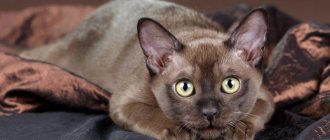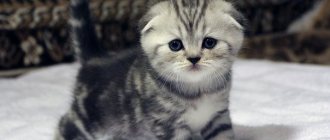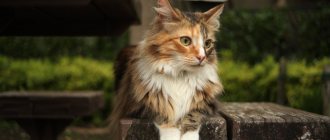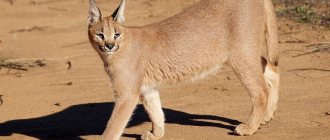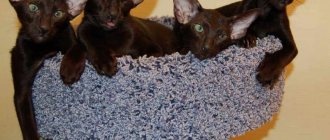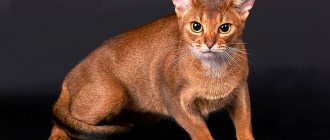History of the origin of the breed
There are many rumors and myths surrounding the origin of the Siberian cat breed. According to some sources, Siberian cats appeared in the Siberian taiga, due to which they have some features of their appearance that helped them survive in difficult climatic conditions.
The Siberian cat is a native long-haired breed and owes its characteristics (appearance, character and endurance) to nature. It is believed that the ancestors of this cat were wild steppe (forest) Siberian cats - predators who are excellent hunters.
The standard for a Siberian cat was determined not so long ago - in the early 90s. Breeders have identified special features of how to identify the breed. They studied what a Siberian cat should be like and gave a detailed description: what it looks like, what its characteristic features are, what its character is and what other features it has.
Read how to care for kittens.
History of the Siberian cat breed
global $ads_google;
//data-ad-slot=”2475549904″ $ads_google = empty($ads_google) ? false : true; ?> if ($ads_google == false) {?> $ads_google = true; ?> } ?> There are no special legends or secrets in the origin of the Siberian cat. The native Russian fluffy cat inspired Russian felinologists in 1980 to select a breed of cats, registered by clubs as Siberian. These were often semi-long-haired creatures, which became breeding material.
At first, the beauties remained popular only within Russia, but history puts everything in its place, and the beauty and amiable nature of the Siberian cat attracted the interest of foreign lovers of meowing creatures. Soon the wonderful cats began to be exported to other countries and the fluffies saw the Czech Republic, the USA, and Germany. There were also difficulties: not everyone was satisfied with the vague description of the cats.
By 1991, an international standard for a new breed had been approved, which remained popular only within Russia. Work to clarify the difference between Siberians and other purebred cats continued. The last approved standard was adopted in 1994, and it is still relevant today. Changes in the description affected the shape of the head and the description of the unique water-repellent three-layer coat of these cats.
Breed standard (appearance):
The first way the Siberian cat differs from others is its size and weight. A powerful, stocky body with fairly well-developed muscles makes these cats majestic. Muscle mass in Siberian kittens takes a long time to form, like in humans, up to 3 years.
The front legs are slightly shorter than the hind legs, which makes the cat's spine slightly sloping (this is what gives the animal strength and agility). The average weight of an adult Siberian cat is 6 kilograms, a male cat is 12 kg.
“Siberians” have large, muscular paws, which distinguish them from other cats by the fact that there are quite long tufts of hair between their toes.
The long hair of the Siberian kitten is hypoallergenic, which makes this cat an indispensable pet for people with allergies. The coat of cats of this breed consists of two layers: a very thick undercoat and a hard coat that practically does not get wet. Thanks to this “coat”, cats feel comfortable in all weather conditions and temperatures. The head of a cat of this breed is quite large, round in shape, and the neck is short but strong. The muzzle has a trapezoidal shape. On their ears you can see tassels inherited from their ancestors.
The eyes are oval in shape, medium in size and slightly slanted.
The color of a Siberian cat can be completely different, as evidenced by the pictures (photos) that you will see below.
Character and some features
The origin of the cat makes itself felt. The Siberian cat is an excellent hunter. Her hunter's instinct is so developed that she will not disappear in any “extreme” conditions. She will dexterously catch not only a mouse, but also a rabbit. This same hunting instinct makes a cat similar to a dog. She (happily) brings things in her teeth. Based on this data, you will know how to name and choose a name for a kitten, a selection of beautiful nicknames.
Fearlessness. “Siberians” protect their space, do not allow outside animals and people in, informing their owners that “strangers” have arrived. They are not at all afraid of dogs, people, or anything that scares ordinary cats (sharp noise, the hum of cars, sirens...).
Learning ability. The Siberian cat is smart and obedient. She can be trained to a certain place for the toilet.
Intelligence, prudence. A cat will never climb anywhere without making sure that it is safe. Before getting a toy out from under a chair (wardrobe, bed), she will think carefully about how to do this.
Siberian cats are not picky. These cats will play with any object (toy, paper, thread...) that is offered to them. Passion for heights. Don't be surprised to see a cat on a refrigerator, cabinet or high up in a tree, as this is completely normal for them.
Restraint towards people. Siberian cats are affectionate, but reserved. They will not constantly ask to be held, but they will never leave their owner when he is ill (sick, upset about something). They will not adapt to their owners, since they themselves consider themselves such. A Siberian cat will be friends with its owner only if the owner respects him.
Health and immunity are much stronger than those of their counterparts. Life expectancy is on average 15-20 years.
Offspring. Siberian cats can give birth to 5-9 (rarely) kittens. The reproductive age of a cat can last up to 18 years, a cat - only up to 11.
Health of Siberians
global $ads_google;
//data-ad-slot=”2475549904″ $ads_google = empty($ads_google) ? false : true; ?> if ($ads_google == false) {?> $ads_google = true; ?> } ?> Like a true Siberian, the cat pleases the owner with its excellent health. Only the owner can damage this natural quality through his careless actions and illiterate care. For example, it is enough not to complete all vaccinations according to the vaccination schedule on time, and a once healthy Siberian cat can contract a serious disease. Even if a cat does not have a walk, it does not mean that at home he lives in complete safety from all diseases.
When the time of puberty comes, and this is approximately 7-9 months, you need to decide whether to breed in the future, because it may be worth castrating or sterilizing an animal from which offspring are not planned. If mating does take place, then pregnancy occurs, lasting 63-69 days.
Siberian cats live 10-15 years.
Care and maintenance
- Cats can take care of their fur on their own, so their owners only need to comb it occasionally: during the molting period (about 10 days) and constantly (1-2 times a month is enough).
- If we talk about nutrition, feeding these cats is not difficult. The fact is that this breed has a genetically programmed program for natural and varied food, which makes it easier to choose feed and food products for them. There is only one feature that is important to consider when feeding Siberian breeds - the amount of protein (during growth). Considering the fact that a kitten’s muscles are formed by the age of 3, its nutrition during these years should be predominantly protein (about 70%).
- Do not forget about their love of freedom and periodically release them into the wild.
Video
Photos of Siberian cats
If you don’t want to waste time loading stories, you can look at the photographs of the Siberian cat, which show various color options:
- blue
- Neva Masquerade
- red (which has a golden tint)
- white
- silver
- black
- tricolor
- tortoiseshell
Conclusions about the breed
The Siberian soul hides in the powerful body of a Siberian cat. The friendly and open creature has retained many of the habits of its ancestors - a love of hunting and natural observation. There are legends about the intelligence of these cats - Siberians do not need to be taught tricks and miracles of training, they themselves, by observing people, begin to understand what they want from them.
The Siberian cat is a wonderful companion who knows how to maintain self-esteem. They have a very developed sense of home and in this quality Siberians are close to dogs. Fearlessness is also their trait. What scares an ordinary cat will only amuse a Siberian cat. Siberian cats are silent and you won’t get any unnecessary sounds from them.
The Siberian cat has no hereditary diseases.
Reviews from Siberian cat owners
Konstantin : “A stuffed animal weighing 9 kilograms – that’s all about our Masik. The cat we got was extremely friendly. Despite the fact that we took him in as an adult, Masik somehow quickly adapted to our family and today the family can no longer imagine itself without this Siberian. Masik is kind and playful - when he is bored, he finds a mouse toy hidden somewhere, brings it into the room and moves his paw with a tender expression on his face. He has become a dad more than once and I must say that all the children adopted his best qualities.”
Albina : “We raise our Siberian cat from a young age - when we adopted the kitten, he was only a month and a half old. Then it was a scratchy ball of fur and nothing has changed in three years. Unfortunately, our cat never learned to play without claws and we all walk around with scratches all year round. The Siberian cat is vengeful and does not forgive even accidental insults. If you accidentally hit a cat, then rest assured that in about 15 minutes he will jump out at you from around the corner with his claws at the ready. But he sleeps so beautifully with his belly up - for this sight we forgive him all his shortcomings! "
Gleb : “Lexus requires special tuning. Lexus is my cat, which requires only the most expensive sausage, only fresh meat and only collective farm sour cream. For these riches, he is ready to pay me back, firstly, with vigorous runs around the apartment at 5 o’clock in the morning, and secondly, with a sofa wonderfully tousled by his claws. Despite its size, Lexus is cowardly, cunning and at the same time very charming. He is friends with me and my son, tolerates his wife and mother-in-law - a real man!”
What to look for when buying a Siberian cat?
When buying a Siberian cat, you need to pay attention first of all to its appearance and behavior. The kitten should not be lethargic, passive, aggressive, withdrawn, or cowardly. When choosing a high-class Siberian, it is recommended to seek the help of professionals who know the breed standard. The breeder needs to clarify information about the health of the selected animal and its parents, in particular, whether there are any hereditary diseases in the family, and if so, which ones; whether vaccination, sterilization or castration (for pet-class cats) has been carried out and other information. You should also inquire about the character traits of your future pet. It is equally important to ensure that the documents are properly prepared and authentic. For this purpose, it is recommended to first look at samples of filling out pedigrees on the clubs’ websites; you can also check the authenticity at the club that issued the document, or seek the help of the same specialist.
Where to buy a Siberian kitten?
You can buy Siberian kittens at a nursery or from a breeder. The cost of a kitten is influenced by many factors (pedigree, color and other features). The lowest price for a purebred Siberian cat will be about 5 thousand rubles (1,200 UAH), the maximum cost can reach 20 thousand rubles (8,000 UAH).
Where to buy a Siberian kitten? We invite you to pay attention to the following nurseries, the reviews of which are only positive:
- Cattery of Siberian cats “Dauria” (https://www.dauriacats.ru/about.html) and nursery “Gloria” in Russia, Moscow.
- Nursery “Girasole” (https://girasole.by) in Belarus, Minsk.
- Nursery “Zaimka” (https://zaimka.com.ua/) in Kyiv.
Choose a fluffy kitten from any nursery or breeder and you will not regret having a Siberian cat as your friend.
At what age can you take a Siberian cat kitten to a new home?
- Why does a cat need a mustache?
- Rescue dogs
- Hypoallergenic cats
- Why does a cat need a tail?
- Chinchilla
- Dog breeds
Siberian cats can be transported to a new owner's home only when they are three months or more old. Until this age, kittens urgently need to communicate with their mother and feed her very healthy milk. Being near her, young Siberians learn useful skills, including eating solid food, lapping, using a tray, scratching post, and communicating with other cats and people. Also, before the third month of life, primary vaccination, sterilization or castration are completed, which new owners will not have to think about. Raising small kittens without experience is always dangerous for the life of the animal. Many breeders prefer to pass on high class Siberians at the age of 4 months.

